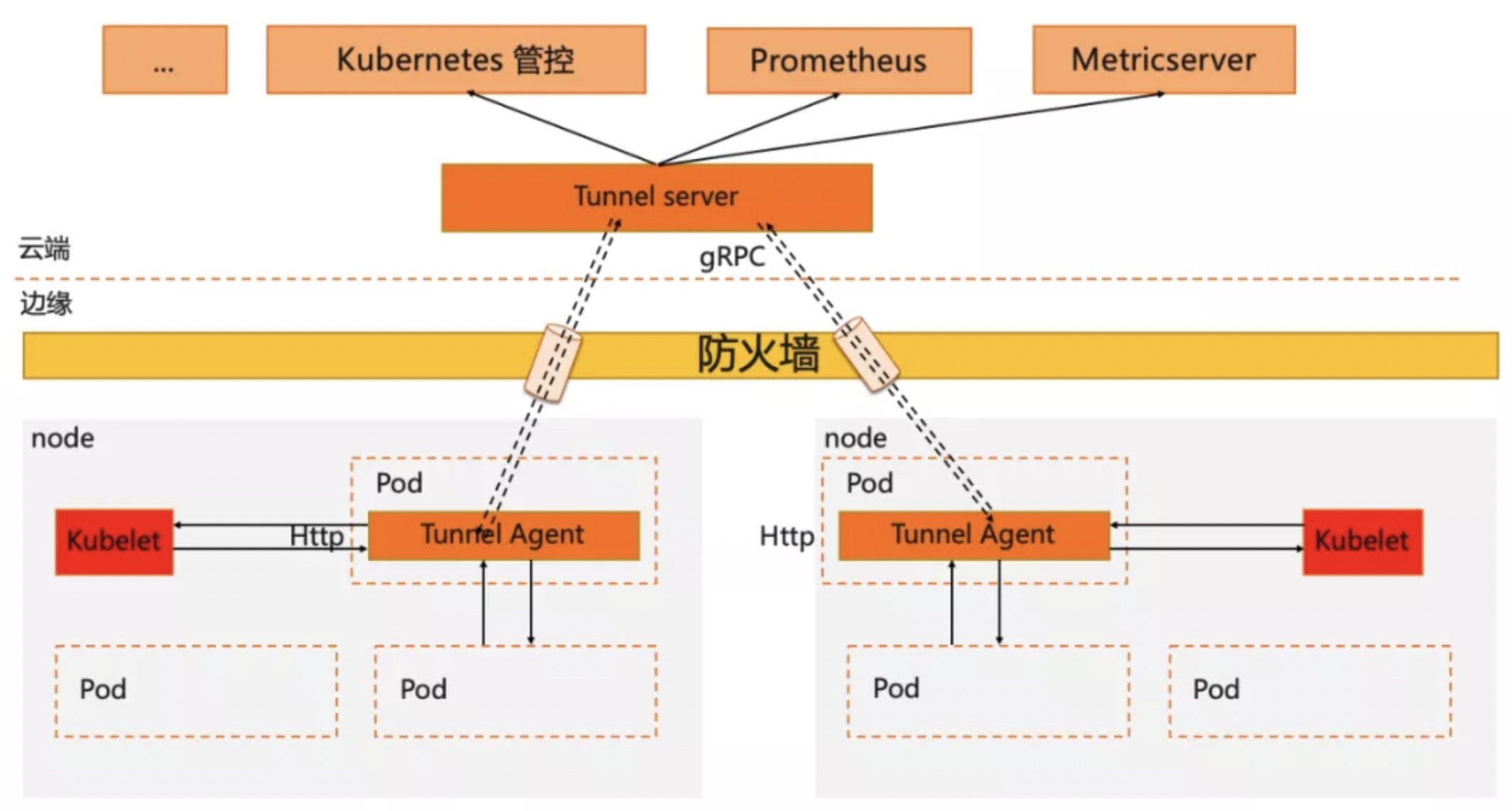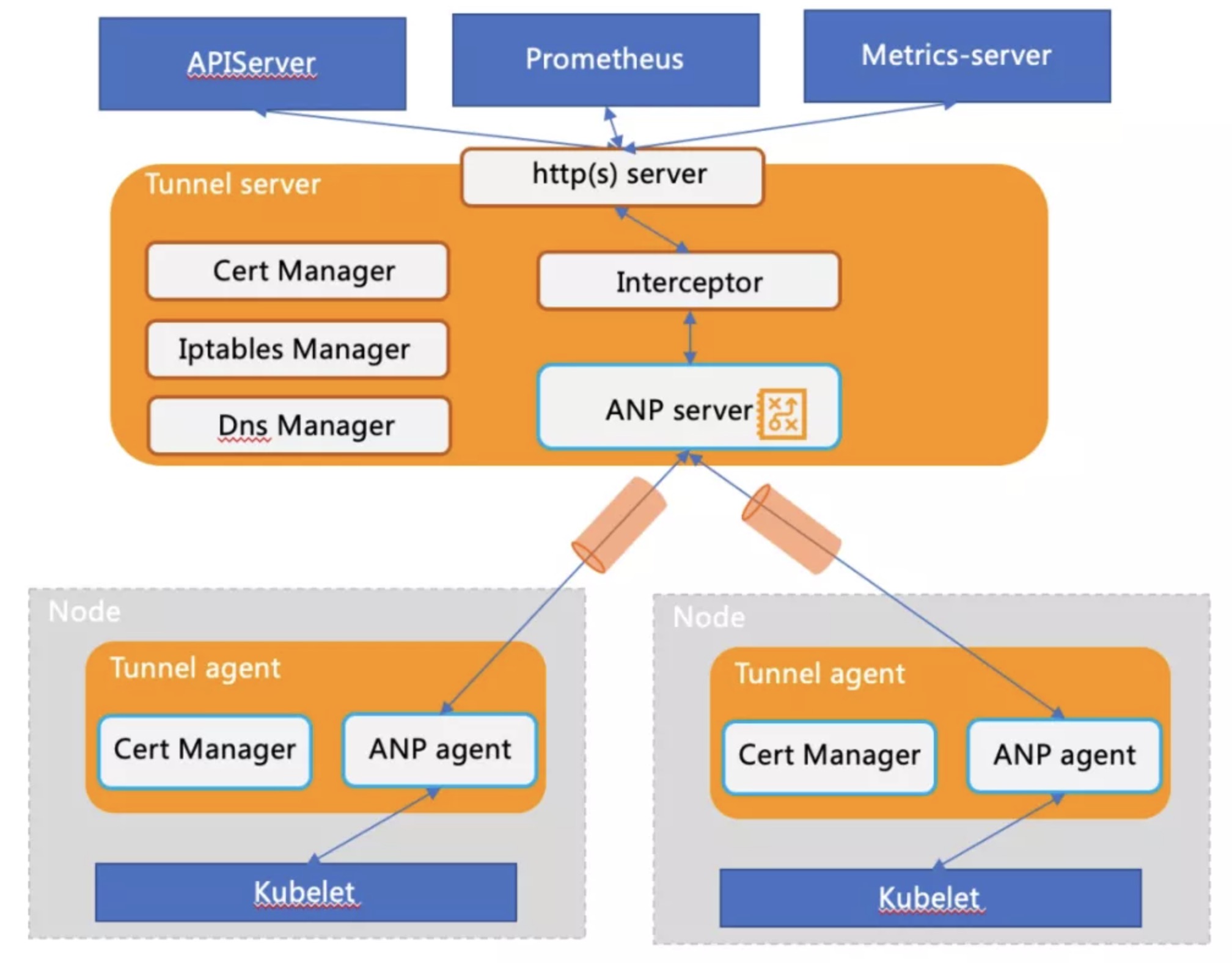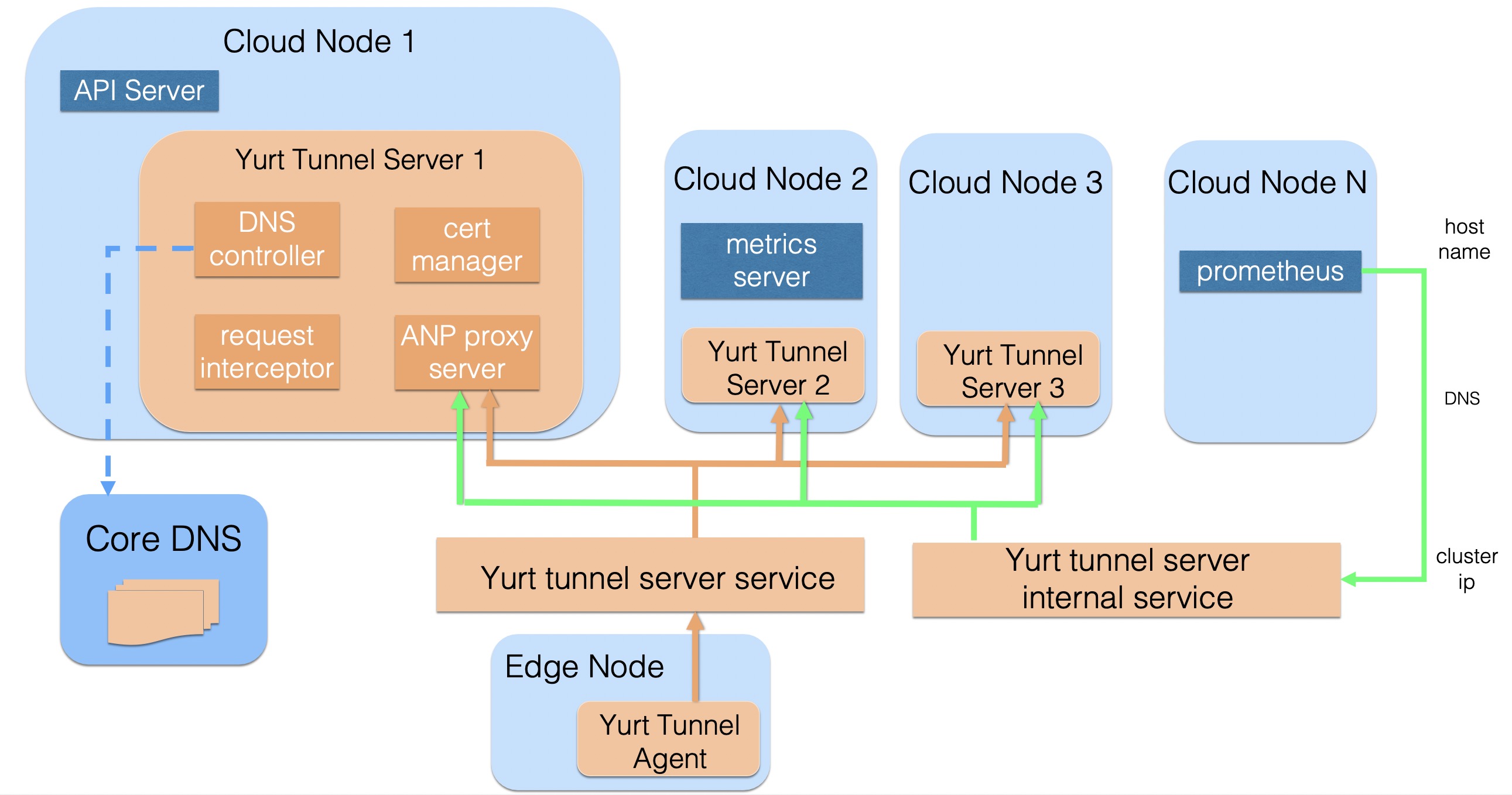YurtTunnel
1. Background
During application deployment and maintenance, users often need to obtain application logs, or directly log in to the running environment of the application for debugging. In Kubernetes cluster, we usually use kubectl log, kubectl exec and other command to debug. As following picture, on kubelet will act as a server, responsible for processing requests forwarded by kube-apiserver (KAS), which requires a network path between KAS and kubelet to allow KAS to actively access kubelet.

Cloud and edge are in different network domains, and edge nodes are inside the firewall. The cloud (center) edge collaborative architecture will lead to the following challenges in the maintenance monitoring capabilities of the native K8s system:
- K8s native maintenance capabilities are lacking (such as
kubectl logs/execcannot be executed) - Community monitoring maintenance components cannot work (such as Prometheus/metrics-server)
In order to support the maintenance of edge applications through cloud nodes, we must establish a reverse maintenance tunnel between the cloud and the edge.
2. Reverse Tunnel
In OpenYurt, we introduced a special component YurtTunnel to deal with the cloud-side communication. Reverse tunnel is a common way to solve cross-network communication, and YurtTunnel is also a reverse tunnel. It is a typical C/S structure component, consisting of Yurt-Tunnel-Server deployed in the cloud and Yurt-Tunnel-Agent deployed on edge nodes. The deployment structure of YurtTunnel is following picture. The whole workflow of the reverse tunnel has the following steps:
- Deploy
Yurt-Tunnel-Serveron the management and control network plane. Yurt-Tunnel-Serveropens an IP accessible from the public network.- Deploy a
Yurt-Tunnel-Agenton each edge node, and establish a long connection with the Server through the Server's public IP. - Access requests from the management and control components to edge nodes will be forwarded to
Yurt-Tunnel-Server. Yurt-Tunnel-Serversends the request to the target node through the long connection.

3. Implementation
To create a secure, non-intrusive, and scalable reverse tunnel in the K8s cloud-edge architecture, it needs to include at least the following three capabilities.
- Tunnel
- Self-management of certificates at both ends of the tunnel
- Cloud component requests are forwarded to the tunnel
Architecture of YurtTunnel is as follows:

- Tunnel
When the Yurt-Tunnel-Agent on the edge starts up, it will establish a connection and register with the Yurt-Tunnel-Server according to the access address, and periodically check the health status of the connection and rebuild the connection.
Yurt-Tunnel-Agent registered is as follows:
"agentID": {NodeName}
"agentIdentifiers": ipv4={nodeIP}&host={NodeName}"
- When
Yurt-Tunnel-Serverreceives a request from a cloud component, it needs to forward the request to theYurt-Tunnel-Agent. Because in addition to forwarding the request, thesessionis followed by data return or continuous data forwarding (such askubectl exec). So it is necessary to forward data in both directions. At the same time, it is necessary to support concurrent forwarding of requests from cloud components, which means that an unique ID needs to be established for each request life cycle. So there are two designs.
Option 1: The initial cloud-side connection only informs the forwarding request, and Yurt-Tunnel-Agent will establish a new connection with the cloud to process the request. Through the new connection, the problem of requesting unique ID can be resolved, and concurrency can also be resolved. But a connection needs to be established for each request, which will consume a lot of resources.
Option 2: Only the initial cloud-edge connection is used to forward requests. In order to reuse the same connection for a large number of requests, it is necessary to encapsulate each request and add an unique ID to solve the concurrent forwarding. At the same time, since a connection needs to be reused, it is necessary to decouple connection management and request lifecycle management. That is to manage the transition of request forwarding. This option involves packet and unpacket, request processing state machine, etc. The option will be a little more complicated.
- The
ANPcomponent selected by OpenYurt adapts the above option 2, which also satisfies our original design intention. - Request forwarding is encapsulated in
Packet_DialRequestandPacket_DialResponse, wherePacket_DialResponse.ConnectIDis used to identifyrequest, which is likerequestIDintunnel. The request and data are encapsulated inPacket_Data.Packet_CloseRequestandPacket_CloseResponseare used to forward and recycle resource. For details, please refer to the following sequence diagram:

-
RequestInterceptormoduleIt can be seen from the above analysis that before
Yurt-Tunnel-Serverforwards the request, the client needs to make anHttp Connectrequest to create a forwarding path. However, it is difficult to do some work for open source components such asPrometheusandmetrics-server. Therefore, a request hijacking moduleInterceptoris added toYurt-Tunnel-Serverto makeHttp Connectrequests.
- Certificate management
In order to keep long and secure communication of cloud-edge, and also to support https request forwarding, YurtTunnel needs to generate its own certificate and maintain the automatic rotation of the certificate. The details are as follows:
# 1. Yurt-Tunnel-Server server certificate:
# https://github.com/openyurtio/openyurt/blob/master/cmd/yurt-tunnel-server/app/start.go#L120-L139
- certificate path: /var/lib/yurt-tunnel-server/pki/yurt-tunnel-server-xxx.pem
- SignerName: "kubernetes.io/kubelet-serving"
- CommonName: "system:node:tunnel-server"
- Organization: {"system:nodes"}
- Subject Alternate Name values: {x-tunnel-server-svc, x-tunnel-server-internal-svc的ips和dns names}
- KeyUsage: ["key encipherment", "digital signature", "server auth"]
# 2. tunnel proxy client certificate: is used by yurt-tunnel-server in order to make connection with components on edge nodes(like kubelet) for forwarding requests.
# https://github.com/openyurtio/openyurt/blob/master/cmd/yurt-tunnel-server/app/start.go#L146-L152
- certificate path: /var/lib/yurt-tunnel-server/pki/yurt-tunnel-server-proxy-client-xxx.pem
- SignerName: "kubernetes.io/kube-apiserver-client"
- CommonName: "tunnel-proxy-client"
- Organization: {"openyurt:yurttunnel"}
- KeyUsage: ["key encipherment", "digital signature", "client auth"]
# 3. Yurt-Tunnel-Agent client certificate:
# https://github.com/openyurtio/openyurt/blob/master/cmd/yurt-tunnel-agent/app/start.go#L99-L107
- certificate path: /var/lib/yurt-tunnel-agent/pki/yurt-tunnel-agent-xxx.pem
- SignerName: "kubernetes.io/kube-apiserver-client"
- CommonName: "tunnel-agent-client"
- Organization: {"openyurt:yurttunnel"}
- KeyUsage: ["key encipherment", "digital signature", "client auth"]
# 4. Yurt-tunnel Certificate Signing Request (CSR) is approved by Yurt-Controller-Manager
# https://github.com/openyurtio/openyurt/blob/master/pkg/controller/certificates/csrapprover.go
# 5. certificate automatic rotation
# https://github.com/kubernetes/kubernetes/blob/master/staging/src/k8s.io/client-go/util/certificate/certificate_manager.go#L224
- transfer cloud component requests to the tunnel
Because the request of the cloud component needs to be forwarded to the Yurt-Tunnel-Server, it also means that no modification to the cloud component is required. So it is necessary to analyze the requests of cloud components. Currently the maintenance requests of components have the following two types:
- type 1: access using IP address, such as:
http://{nodeIP}:{port}/{path} - type 2: access using domain name, such as:
http://{NodeName}:{port}/{path}
Different solutions need to be adopted for different types of requests.
Solution 1: Use iptables dnat rules to ensure that type 1 requests are forwarded to Yurt-Tunnel-Server
# iptables rules code: https://github.com/openyurtio/openyurt/blob/master/pkg/yurttunnel/iptables/iptables.go
# The iptables dnat rules maintained by Yurt-Tunnel-Server are as follows:
[root@xxx /]# iptables -nv -t nat -L OUTPUT
TUNNEL-PORT tcp -- * * 0.0.0.0/0 0.0.0.0/0 /* edge tunnel server port */
[root@xxx /]# iptables -nv -t nat -L TUNNEL-PORT
TUNNEL-PORT-10255 tcp -- * * 0.0.0.0/0 0.0.0.0/0 tcp dpt:10255 /* jump to port 10255 */
TUNNEL-PORT-10250 tcp -- * * 0.0.0.0/0 0.0.0.0/0 tcp dpt:10250 /* jump to port 10250 */
[root@xxx /]# iptables -nv -t nat -L TUNNEL-PORT-10255
RETURN tcp -- * * 0.0.0.0/0 127.0.0.1 /* return request to access node directly */ tcp dpt:10255
RETURN tcp -- * * 0.0.0.0/0 172.16.6.156 /* return request to access node directly */ tcp dpt:10255
DNAT tcp -- * * 0.0.0.0/0 0.0.0.0/0 /* dnat to tunnel for access node */ tcp dpt:10255 to:172.16.6.156:10264
Solution 2: Use dns domain name to resolve NodeName as the access address of Yurt-Tunnel-Server, so that type 2 requests can be forwarded to yurt-tunnel. Its working principle is as follows:

Yurt-Tunnel-Servermaintains two Service addresses:- x-tunnel-server-svc: expose port 10262/10263 used to access from the public networkYurt-Tunnel-Server. Such as Yurt-Tunnel-Agent
- x-tunnel-server-internal-svc: cloud components is accessed from the internal network, such as prometheus, metrics-server
Yurt-Tunnel-Serverhas a DNS Controller, dynamically configures Core DNS Host records, and maintains the mapping relationship between NodeName and IP (Cloud Node is directly reachable according to IP, directly mapped to Node IP; Edge Node needs to communicate through the Tunnel tunnel agent, mapping to the cluster ip ofYurt-Tunnel-ServerInternal Service)- When the cloud component accesses the Edge node through NodeName, it will do domain name resolution through CoreDNS by default, and the request for the Edge Node will be directed to the ClusterIP of the internal service of
Yurt-Tunnel-Server, and then use the forwarding ability of kube-proxy to forward the request Load balancing to healthy Yurt-Tunnel-Server Pods Yurt-Tunnel-Serverwill check the requested Host. When the Host is NodeName, it will find the correct Agent backend through the node name and forward the data
- port extension
If users need to access other ports(like 9051 for http requests) on the edge (other than 10250 and 10255), they need to add dnat rules in iptables or add port mapping in x-tunnel-server-internal-svc, as shown following:
# For example, access port 9051 of the edge
# add iptables dnat rule:
[root@xxx /]# iptables -nv -t nat -L TUNNEL-PORT
TUNNEL-PORT-9051 tcp -- * * 0.0.0.0/0 0.0.0.0/0 tcp dpt:9051 /* jump to port 9051 */
[root@xxx /]# iptables -nv -t nat -L TUNNEL-PORT-9051
RETURN tcp -- * * 0.0.0.0/0 127.0.0.1 /* return request to access node directly */ tcp dpt:9051
RETURN tcp -- * * 0.0.0.0/0 172.16.6.156 /* return request to access node directly */ tcp dpt:9051
DNAT tcp -- * * 0.0.0.0/0 0.0.0.0/0 /* dnat to tunnel for access node */ tcp dpt:9051 to:172.16.6.156:10264
# add port mapping in x-tunnel-server-internal-svc
spec:
ports:
- name: https
port: 10250
protocol: TCP
targetPort: 10263
- name: http
port: 10255
protocol: TCP
targetPort: 10264
- name: dnat-9051 # add port mapping
port: 9051
protocol: TCP
targetPort: 10264
The above iptables dnat rules and service port mapping are automatically updated by Yurt-Tunnel-Server. Users only need to add port configuration in yurt-tunnel-server-cfg configmap in kube-system. details as follows:
apiVersion: v1
data:
http-proxy-ports: "9051" # ports for HTTP requests
https-proxy-ports: "" # ports for HTTPs requests
kind: ConfigMap
metadata:
name: yurt-tunnel-server-cfg
namespace: kube-system